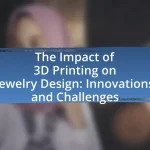The article explores the contrasting methodologies of traditional and contemporary techniques in jewelry making. It delves into traditional methods such as lost-wax casting, filigree, and stone setting, highlighting their historical significance and craftsmanship. The evolution of these techniques over time is examined, alongside the impact of modern technologies like 3D printing and CAD, which enhance design precision and efficiency. Additionally, the article discusses the materials commonly used in both approaches, the key processes involved, and the challenges faced by traditional artisans in a rapidly changing market. Finally, it addresses the integration of sustainability practices and the potential for combining both traditional and contemporary techniques to create innovative jewelry designs.

What are Traditional Techniques in Jewelry Making?
Traditional techniques in jewelry making include methods such as lost-wax casting, filigree, granulation, and stone setting. Lost-wax casting, which dates back to ancient civilizations, involves creating a wax model of the jewelry piece, encasing it in a mold, and then melting away the wax to pour molten metal into the cavity. Filigree is characterized by delicate, lace-like designs made from thin wires of metal, often used in cultures like the ancient Greeks and Romans. Granulation involves the application of tiny metal balls to a surface, a technique that has been used since the Etruscan period. Stone setting is the process of securing gemstones into the metal framework, which has been practiced for centuries across various cultures. These techniques have been foundational in the evolution of jewelry making, showcasing craftsmanship and artistry throughout history.
How have traditional techniques evolved over time?
Traditional techniques in jewelry making have evolved significantly over time, transitioning from purely manual craftsmanship to incorporating modern technology and materials. Initially, artisans relied on hand tools and basic methods, such as forging and soldering, to create intricate designs. As industrialization progressed in the 19th century, techniques like electroforming and casting emerged, allowing for more complex shapes and mass production. The introduction of computer-aided design (CAD) in the late 20th century further revolutionized the field, enabling precise modeling and rapid prototyping. This evolution reflects a blend of heritage and innovation, where traditional skills are enhanced by contemporary tools, resulting in a diverse range of jewelry styles and production methods.
What historical influences shaped traditional jewelry making?
Historical influences that shaped traditional jewelry making include cultural practices, trade routes, and technological advancements. For instance, ancient civilizations such as the Egyptians and Mesopotamians utilized gold and gemstones in their jewelry, reflecting their beliefs in the afterlife and social status. The Silk Road facilitated the exchange of materials and techniques between East and West, leading to diverse styles and methods in jewelry crafting. Additionally, the introduction of metallurgy during the Bronze Age allowed for more intricate designs and durability in jewelry pieces. These factors collectively contributed to the evolution of traditional jewelry making across different cultures and eras.
Which materials are commonly used in traditional techniques?
Traditional techniques in jewelry making commonly utilize materials such as gold, silver, copper, and gemstones. These materials have been historically favored due to their availability, durability, and aesthetic appeal. For instance, gold and silver have been used for thousands of years in various cultures for their malleability and resistance to tarnish, making them ideal for intricate designs. Copper, often used in ancient jewelry, is valued for its workability and unique color. Gemstones, including diamonds, rubies, and emeralds, have been prized for their beauty and rarity, often symbolizing wealth and status. The consistent use of these materials across different cultures and time periods underscores their significance in traditional jewelry-making techniques.
What are the key processes involved in traditional jewelry making?
The key processes involved in traditional jewelry making include design, metalworking, stone setting, and finishing. Design involves creating sketches or models to visualize the final piece, often inspired by cultural motifs or personal preferences. Metalworking encompasses techniques such as forging, casting, and soldering to shape and assemble the jewelry components. Stone setting is the process of securely placing gemstones into the metal framework, which requires precision to enhance the overall aesthetic. Finally, finishing involves polishing and adding any final touches to ensure the piece is visually appealing and ready for wear. These processes have been refined over centuries, reflecting the craftsmanship and cultural significance inherent in traditional jewelry making.
How is metalworking performed in traditional techniques?
Metalworking in traditional techniques is performed through methods such as forging, casting, and soldering. Forging involves shaping metal using compressive forces, often with hammers or presses, which has been practiced since ancient times, evidenced by artifacts dating back to 3000 BCE. Casting entails pouring molten metal into molds to create specific shapes, a technique utilized in various cultures, including the lost-wax casting method used in ancient Egypt. Soldering, which joins metal pieces together using a filler metal, has roots in early jewelry making, with historical records indicating its use in Europe as far back as the Middle Ages. These traditional techniques emphasize craftsmanship and manual skill, reflecting the historical context and cultural significance of metalworking in jewelry making.
What role does stone setting play in traditional jewelry making?
Stone setting is crucial in traditional jewelry making as it secures gemstones in place, enhancing both the aesthetic appeal and structural integrity of the piece. This technique involves various methods, such as prong, bezel, and channel settings, each designed to showcase the stone while ensuring durability. Historically, skilled artisans have employed these methods for centuries, with evidence of stone setting techniques dating back to ancient civilizations like the Egyptians and Greeks, who used them to create intricate and lasting adornments. The precision in stone setting not only elevates the visual impact of jewelry but also reflects the craftsmanship and cultural significance inherent in traditional jewelry making.

What are Contemporary Techniques in Jewelry Making?
Contemporary techniques in jewelry making include 3D printing, laser cutting, and the use of alternative materials such as resin and synthetic stones. These methods allow for intricate designs and precision that traditional techniques may not achieve. For instance, 3D printing enables the creation of complex geometries that can be customized easily, while laser cutting provides clean edges and detailed patterns. Additionally, the incorporation of materials like resin offers versatility in color and texture, expanding creative possibilities for jewelers. These advancements reflect a shift towards innovation in the jewelry industry, enhancing both the aesthetic and functional aspects of jewelry design.
How do contemporary techniques differ from traditional methods?
Contemporary techniques in jewelry making differ from traditional methods primarily through the use of advanced technology and innovative materials. Traditional methods often rely on manual craftsmanship and time-honored practices, such as hand-forging and soldering, which have been passed down through generations. In contrast, contemporary techniques incorporate tools like computer-aided design (CAD) software, 3D printing, and laser cutting, allowing for greater precision and the ability to create complex designs that would be difficult or impossible to achieve by hand. For example, a study published in the Journal of Jewelry Technology highlights that CAD technology enables jewelers to visualize and modify designs rapidly, significantly reducing production time and material waste compared to traditional methods.
What modern technologies are utilized in contemporary jewelry making?
Modern technologies utilized in contemporary jewelry making include 3D printing, computer-aided design (CAD), laser cutting, and digital engraving. These technologies enable jewelers to create intricate designs with precision and efficiency. For instance, 3D printing allows for rapid prototyping and the production of complex shapes that would be difficult to achieve through traditional methods. CAD software facilitates detailed design work, enabling jewelers to visualize and modify their creations before production. Laser cutting provides high accuracy in cutting materials, while digital engraving allows for personalized designs and intricate detailing. The integration of these technologies has transformed the jewelry-making process, enhancing creativity and reducing production time.
How has the approach to design changed in contemporary techniques?
The approach to design in contemporary techniques has shifted towards a more inclusive and technology-driven methodology. Contemporary designers increasingly utilize digital tools such as CAD (Computer-Aided Design) software, which allows for precise modeling and rapid prototyping, enhancing creativity and efficiency. This transition is evidenced by the rise of 3D printing in jewelry making, enabling intricate designs that were previously difficult or impossible to achieve with traditional methods. Additionally, contemporary design emphasizes sustainability and ethical sourcing, reflecting a growing consumer demand for responsible practices in the jewelry industry. This evolution in design approach not only broadens the scope of creativity but also aligns with modern values, making it a significant departure from traditional techniques.
What are the benefits of using contemporary techniques?
The benefits of using contemporary techniques in jewelry making include increased efficiency, enhanced creativity, and improved precision. Contemporary techniques often incorporate advanced technologies such as computer-aided design (CAD) and 3D printing, which streamline the design process and reduce production time. For instance, CAD allows jewelers to create intricate designs that would be difficult or impossible to achieve by hand, while 3D printing enables rapid prototyping and customization. Additionally, contemporary methods often utilize innovative materials and sustainable practices, appealing to modern consumers who prioritize eco-friendliness. These advancements not only elevate the quality of the final product but also expand the possibilities for artistic expression in jewelry design.
How do contemporary techniques enhance creativity in jewelry design?
Contemporary techniques enhance creativity in jewelry design by integrating advanced technologies such as 3D printing, computer-aided design (CAD), and innovative materials. These methods allow designers to experiment with complex shapes and intricate details that traditional techniques may not accommodate. For instance, 3D printing enables the rapid prototyping of unique designs, facilitating a more exploratory creative process. Additionally, CAD software provides precise control over design elements, allowing for intricate customization and the ability to visualize concepts in real-time. The use of new materials, such as bio-resins and sustainable metals, further expands the creative possibilities, enabling designers to push boundaries and create pieces that reflect modern aesthetics and values.
What sustainability practices are integrated into contemporary jewelry making?
Contemporary jewelry making integrates several sustainability practices, including the use of ethically sourced materials, recycled metals, and environmentally friendly production methods. Ethically sourced materials ensure that gemstones and metals are obtained without exploiting workers or harming the environment, as seen in certifications like Fair Trade and Responsible Jewelry Council standards. The use of recycled metals reduces the demand for newly mined resources, which can be environmentally destructive; for instance, using recycled gold can save up to 90% of the energy required for new gold extraction. Additionally, environmentally friendly production methods, such as using non-toxic chemicals and minimizing waste, further enhance sustainability in the jewelry industry. These practices collectively contribute to a more responsible and eco-conscious approach to jewelry making.

How do Traditional and Contemporary Techniques Compare?
Traditional techniques in jewelry making often emphasize handcrafted methods, utilizing tools and materials that have been used for centuries, such as hand-forging, soldering, and stone setting. In contrast, contemporary techniques frequently incorporate modern technology, including computer-aided design (CAD) and 3D printing, allowing for precision and innovative designs that were previously unattainable. The comparison highlights that traditional methods focus on artisanal craftsmanship and heritage, while contemporary approaches prioritize efficiency, scalability, and design flexibility. For instance, a study by the Gemological Institute of America indicates that the integration of CAD in jewelry design has increased production speed by up to 50%, showcasing the impact of contemporary techniques on the industry.
What are the strengths and weaknesses of traditional techniques?
Traditional techniques in jewelry making possess strengths such as craftsmanship, cultural heritage, and the ability to create unique, handcrafted pieces. These techniques often emphasize skill and artistry, resulting in high-quality, durable jewelry that reflects the artisan’s personal touch. For example, methods like hand engraving and stone setting have been used for centuries, showcasing the intricate work that can only be achieved through traditional practices.
However, traditional techniques also have weaknesses, including time consumption, limited scalability, and higher production costs. The labor-intensive nature of these methods can lead to longer production times, making it challenging to meet high demand. Additionally, traditional techniques may lack the precision and consistency offered by contemporary technologies, such as computer-aided design (CAD) and 3D printing, which can produce intricate designs more efficiently and at a lower cost.
How do traditional techniques impact craftsmanship and artistry?
Traditional techniques significantly enhance craftsmanship and artistry by fostering a deep understanding of materials and processes. These techniques, such as hand-forging, stone-setting, and enameling, require extensive skill and knowledge, which cultivates a high level of precision and attention to detail in the final product. Historical evidence shows that artisans who employ traditional methods often produce pieces that reflect cultural heritage and personal expression, as seen in the intricate designs of ancient jewelry from civilizations like the Egyptians and Greeks. This connection to history not only enriches the artistic value of the work but also preserves techniques that might otherwise be lost, ensuring that craftsmanship remains a vital part of artistic expression in jewelry making.
What challenges do traditional techniques face in modern markets?
Traditional techniques in jewelry making face significant challenges in modern markets, primarily due to the rise of advanced technology and changing consumer preferences. These techniques often struggle to compete with contemporary methods that utilize automation, which allows for faster production and lower costs. For instance, 3D printing technology enables the creation of intricate designs that would be labor-intensive and time-consuming using traditional methods. Additionally, modern consumers increasingly prioritize sustainability and ethical sourcing, which can be difficult for traditional artisans to demonstrate without transparent supply chains. According to a 2021 survey by the Jewelers of America, 70% of consumers prefer brands that are environmentally responsible, highlighting the pressure on traditional techniques to adapt.
What are the advantages and disadvantages of contemporary techniques?
Contemporary techniques in jewelry making offer several advantages and disadvantages. The advantages include increased efficiency and precision due to advanced tools and technologies, such as computer-aided design (CAD) and laser cutting, which allow for intricate designs that may be difficult to achieve by hand. Additionally, contemporary techniques often enable the use of a wider variety of materials, including synthetic stones and innovative alloys, which can enhance creativity and reduce costs.
On the other hand, the disadvantages of contemporary techniques include a potential loss of traditional craftsmanship and the personal touch that comes with handmade jewelry. Some artisans argue that reliance on technology can diminish the skill and artistry involved in the craft. Furthermore, contemporary methods may lead to a homogenization of designs, as mass production techniques can result in less unique pieces.
How do contemporary techniques affect production speed and cost?
Contemporary techniques significantly enhance production speed and reduce costs in jewelry making. Advanced technologies such as 3D printing and computer-aided design (CAD) streamline the design process, allowing for rapid prototyping and modifications, which can cut production time by up to 50%. Additionally, automation in manufacturing processes minimizes labor costs and material waste, leading to overall cost reductions. For instance, a study by the Jewelers of America found that jewelers using CAD and 3D printing reported a 30% decrease in production costs compared to traditional methods. These contemporary techniques not only improve efficiency but also enable greater design complexity without proportional increases in cost.
What limitations exist within contemporary jewelry making practices?
Contemporary jewelry making practices face several limitations, including the high cost of materials, reliance on technology, and environmental concerns. The high cost of precious metals and gemstones can restrict accessibility for both artisans and consumers, limiting the diversity of designs and the ability to experiment with materials. Additionally, the increasing reliance on technology, such as 3D printing and CAD software, can lead to a loss of traditional craftsmanship skills, which are essential for creating unique, handcrafted pieces. Environmental concerns also pose limitations, as the jewelry industry grapples with the impact of mining and production processes on ecosystems, prompting a shift towards sustainable practices that may not always align with contemporary methods.
How can jewelers effectively combine traditional and contemporary techniques?
Jewelers can effectively combine traditional and contemporary techniques by integrating age-old craftsmanship with modern technology, such as CAD (Computer-Aided Design) software. This approach allows artisans to maintain the intricate details and quality of traditional methods while enhancing precision and efficiency through contemporary tools. For instance, jewelers can use traditional hand-engraving techniques alongside 3D printing to create unique designs that are both artistically rich and technically advanced. This fusion not only preserves the heritage of jewelry making but also meets the evolving demands of modern consumers, who often seek personalized and innovative pieces.
What best practices should jewelers follow when choosing techniques?
Jewelers should prioritize a combination of skill proficiency, material compatibility, and design intent when choosing techniques. Skill proficiency ensures that the jeweler can effectively execute the chosen method, whether it be traditional techniques like soldering or contemporary methods such as 3D printing. Material compatibility is crucial, as different materials require specific techniques for optimal results; for instance, certain metals may not withstand high temperatures used in some soldering methods. Additionally, aligning the technique with the design intent allows for the creation of pieces that meet aesthetic and functional goals. Research indicates that jewelers who assess these factors tend to produce higher quality and more innovative designs, enhancing both craftsmanship and customer satisfaction.


